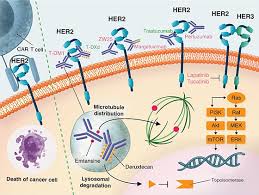HER2-negative gastric or gastroesophageal junction (GEJ) adenocarcinoma is a challenging form of cancer with distinct characteristics that require specialized treatment approaches. Understanding its pathology, diagnosis, and treatment strategies is crucial for improving patient outcomes.

Understanding HER2-Negative Gastric and GEJ Adenocarcinoma
HER2-negative gastric and GEJ adenocarcinoma refers to cancers that lack the overexpression of the HER2 protein. These cancers are more difficult to treat due to their limited response to targeted therapies like trastuzumab.
Characteristics of HER2-Negative Gastric Adenocarcinoma
- Absence of HER2 protein overexpression or gene amplification
- Higher prevalence in non-cardia gastric cancers
- Associated with chronic inflammation, Helicobacter pylori infection, and environmental factors
Common Symptoms
- Persistent abdominal pain
- Unexplained weight loss
- Difficulty swallowing (dysphagia)
- Early satiety
- Nausea and vomiting
- Blood in stool or vomit
Diagnosis of HER2-Negative Gastric and GEJ Adenocarcinoma
Early detection is crucial for improving prognosis. The following diagnostic tools are essential:
Endoscopy with Biopsy
Endoscopy remains the gold standard for identifying gastric and GEJ tumors. Biopsies obtained during endoscopy are examined for malignancy and HER2 status.
Imaging Techniques
- CT Scans for staging and identifying metastases
- PET Scans to detect distant metastases
- Endoscopic Ultrasound (EUS) for tumor depth assessment
Immunohistochemistry (IHC) and Fluorescence In Situ Hybridization (FISH)
These methods confirm HER2-negative status and help guide treatment decisions.
Treatment Options for HER2-Negative Gastric and GEJ Adenocarcinoma
Treatment strategies vary depending on the stage and location of the tumor, as well as the patient’s overall health.
Surgical Intervention
- Endoscopic Resection for early-stage cancers
- Partial or Total Gastrectomy for advanced cases
- Esophagectomy in GEJ adenocarcinoma
Chemotherapy
Systemic chemotherapy is often the primary treatment for HER2-negative cases. Common regimens include:
- FOLFOX (5-FU, leucovorin, oxaliplatin)
- Cisplatin and Capecitabine
- Irinotecan-based regimens
Immunotherapy
Immune checkpoint inhibitors like pembrolizumab have shown promising results, particularly in patients with PD-L1 expression.
Radiation Therapy
Used alongside chemotherapy to reduce tumor size or manage symptoms in advanced cases.
Prognosis and Survival Rates
Prognosis varies based on factors such as tumor stage, location, and response to treatment. Early detection significantly improves survival rates.
Preventive Measures and Risk Reduction
- Eradication of H. pylori infection
- Maintaining a healthy diet rich in fruits and vegetables
- Avoiding smoking and limiting alcohol consumption
- Regular screenings for high-risk individuals
Emerging Research and Future Directions
- Novel Immunotherapies: Research is advancing checkpoint inhibitors and monoclonal antibodies.
- Biomarker Development: Identifying genetic markers may personalize treatment strategies.
- Combination Therapies: Combining chemotherapy with immunotherapy is improving outcomes in clinical trials.
HER2-negative gastric and GEJ adenocarcinoma presents unique challenges, yet advancements in diagnostics, treatment options, and research are improving survival outcomes. Early diagnosis, multidisciplinary care, and tailored therapies are key to better prognoses.